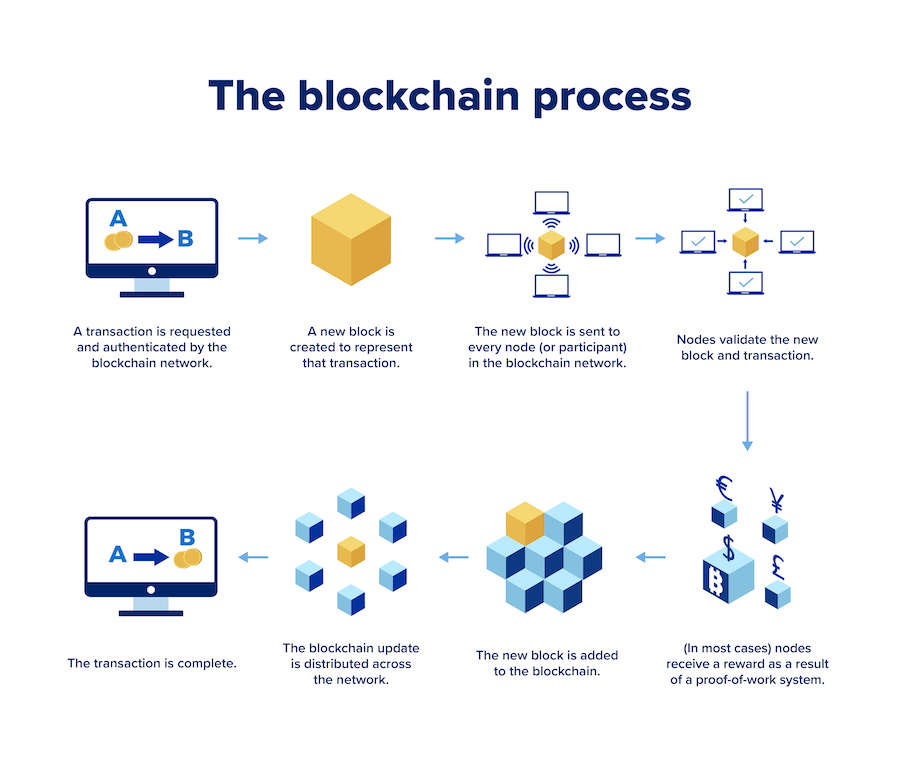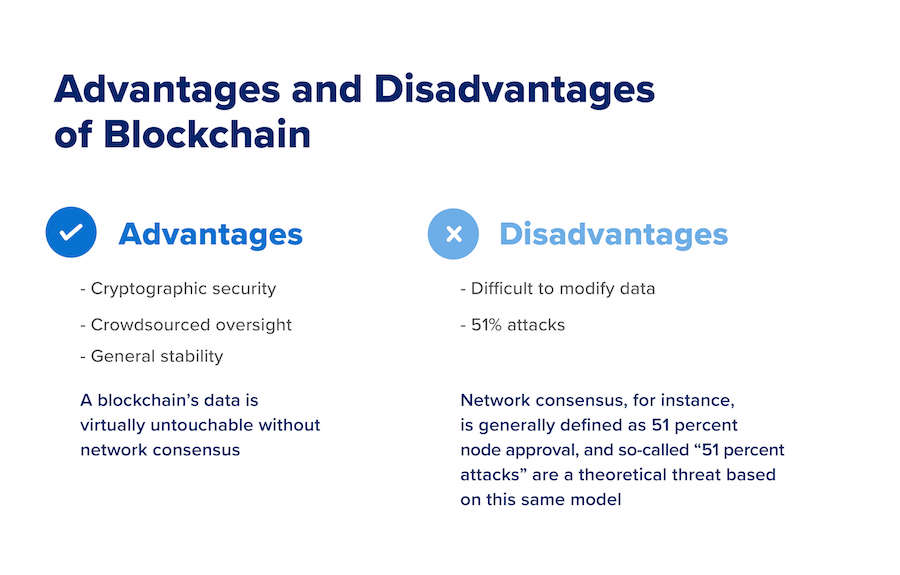What Is Blockchain? A Beginner’s Guide for 2021

Over the past few decades, blockchain has evolved from a curious technology buzzword to a bold new frontier for our collective digital infrastructure. Its potential has transcended industries and has the power to revolutionize everything from healthcare to online gaming.
But what is blockchain? Broadly speaking, a blockchain is a highly secure, communal chain of data that helps business networks exchange assets, store information, and record transactions. These digital ledgers make use of consensus and permanent record-keeping to make such processes more efficient, trustworthy, and safe for all involved parties.
Here, we will provide a comprehensive overview of blockchain for beginners, examining the technology’s history, current array of uses, and growing list of functional characteristics. We will also outline a few educational options for learning blockchain en route to a potential fintech career, including enrolling in an online fintech bootcamp, an effective means of learning skills applicable to both blockchain and cryptocurrency (or virtual currency secured through data encryption).
Blockchain 101: Understanding the Basics
What is blockchain technology? How does blockchain work? What is blockchain used for?
You may find yourself asking these questions at the mere mention of blockchain, and this is completely understandable. Despite its growing prominence, the term remains an enigma to many. However, by gaining a working understanding of blockchain basics, you will be better able to understand the concept and its growing importance in the digital age.
Blockchain Defined
In essence, blockchain is simply a type of database. However, the key difference between blockchain and common databases is the way the data is structured. Unlike standard databases which store data in centralized, relational tables, blockchain is an open, peer-to-peer (P2P) network that favors communal functionality in lieu of a centralized controlling entity.
In blockchain, data is collected into groupings called blocks. Each block has a certain storage capacity so, when it is filled, it is linked to the previously filled block forming a chain of data — hence the name “blockchain.” When additional information is subsequently added, another new block is formed and added to the existing blockchain.
An important characteristic of blockchain is that, as each block is completed, a time stamp is generated. This makes each blockchain a “timeline of data”; differentiating it from standard databases as well.
A Brief History of Blockchain
While blockchain currently commands a lot of attention, its basic characteristics are hardly a new concept. The technology dates back to 1991, when a group of researchers first described the idea of cryptographically securing data in a chain of blocks, time-stamping the chain so it would be impossible to overwrite or tamper with the data. This concept became the subject of scholarly study and experimentation throughout the next decade.
Then, in 2008, a developer under the pseudonym Satoshi Nakamoto introduced a model that would become the first functional blockchain that went on to be used as the first public ledger for Bitcoin trading. Since this breakthrough, the technology has grown to surpass its cryptocurrency implications alone, introducing new data-oriented possibilities for countless industries. Today, with innovative entities like Ethereum and Ripple leading the charge, blockchain represents a full-fledged paradigm shift for data sharing, storage, and fortification.
How Does Blockchain Work?
At its core, a blockchain allows a network of individuals to share potentially valuable data in a tamper-proof way. The type of data in question often depends on the blockchain’s industry or purpose. For example, a cryptocurrency-based blockchain stores information on crypto transactions, including the trader, recipient, and amount of currency being exchanged.
The Blockchain Process
- A transaction is requested and authenticated by the blockchain network.
- A new block is created to represent that transaction.
- The new block is sent to every node (or participant) in the blockchain network.
- Nodes validate the new block and transaction.
- (In most cases) nodes receive a reward as a result of a proof-of-work system.
- The new block is added to the blockchain.
- The blockchain update is distributed across the network.
- The transaction is complete.

Blockchains are also streamlined via smart contracts, or programs that activate when predetermined conditions are met. Smart contracts are essentially lines of code acting as an agreement between two parties, and in a blockchain, they are used to automatically process transactions without the need for a third party to oversee the exchange.
Since blockchain data is encrypted, cross-checked, and decentralized, it is incredibly difficult to change or steal. To hack this data would entail concurrently penetrating all blocks in a single blockchain, which is almost impossible to feasibly pull off.
Blockchain Components
Each chain is based on three crucial components: blocks, nodes, and miners.
Blocks
Blocks are the clusters of data that act as the chain’s links, and include two important numbers called nonces and hashes. Nonces are 32-bit whole numbers generated when a block is created, while hashes are 256-bit numbers linked to the nonce and used to identify that specific block’s data (think of them as fingerprints).
After a blockchain’s first block (or “genesis block”) is created, its nonce generates a hash, at which point the block is considered signed and permanently bound to the nonce and hash. This makes the block’s data cryptographically secure.
Nodes
Nodes are essentially devices that are capable of participating in a blockchain. When a new node joins a blockchain, it is given its own copy of the chain, and in order to make additions or changes to the chain as a whole, the node’s actions must be algorithmically approved by the blockchain’s network.
For example, if one node creates a new block, that block is sent to everyone on the network, and the other nodes confirm that the block is viable and hasn’t been tampered with. This communal agreement is known as “consensus,” and it is the framework of a blockchain’s impeccable security.
Miners
Blockchain miners are responsible for changing (or “mining”) a blockchain’s data, creating new blocks by means of consensus. This is done by finding the right nonce-hash combination in a single block (also known as the “golden nonce”).
Since each block has a unique nonce and hash linked to the hash of the previous block, there are billions of possible nonce-hash combinations that must be mined to successfully change the block; making mining a time-consuming process warranting high-level math skills and advanced analytical software. However, when a change is finally executed and accepted by the network, the miner is rewarded financially.
Advantages and Disadvantages of Blockchain
While blockchain’s decentralized infrastructure comes with a plethora of advantages, the technology also poses a variety of potential disadvantages. Here is a closer look at blockchain’s notable pros and cons:
Blockchain Advantages
As noted earlier, blockchain’s primary advantages stem from its cryptographic security, crowdsourced oversight, and general stability. A blockchain’s data is virtually untouchable without network consensus and, paired with the inherent uniqueness of each block, mitigating the possibility of hacking and other malicious activity.
Blockchain Disadvantages
Blockchain’s biggest strengths could potentially become its undoing without consistent caution. Network consensus, for instance, is generally defined as 51 percent node approval, and so-called “51 percent attacks” are a theoretical threat based on this same model. In other words, if a hacker were to gain 51 percent control of a blockchain’s network, they would be able to manipulate the chain’s hashing power, disrupt transactions, and jeopardize stored data.
At the same time, blockchain’s immutable nature can be a hurdle when positive data modifications are needed (hence the difficulty of the mining process). Changes are usually very demanding and can occasionally result in splitting the chain into two separate networks — the original version, which is ultimately abandoned over time, and a new version based on the updates.

Blockchain & Cryptocurrency Trends for 2021
Both blockchain and cryptocurrency have produced noteworthy trends during 2021; here are a few worth watching.
Enterprise Blockchain
As mentioned earlier, blockchain has historically been predicated on open-source communities instead of systems where the chain is operated by a single entity; however, enterprise blockchain represents a new form of this concept. In an enterprise blockchain, networks fall under the control of a centralized owner (usually the company deploying the chain). This year has seen the continued rise of enterprise blockchain, with such investments forecasted to jump by 50% by the year’s end.
NFTs
Non-fungible tokens (NFTs) have ignited quite a bit of conversation this year. These digital assets are contained within blockchains and are completely unique. NFTs can essentially be any digital file — audio files, videos, pictures, etc. — and contain built-in authentication; serving as proof of ownership which enhances the value of the digital asset. Sports, gaming, music, and art are just a few industries beginning to implement the NFT-based release of limited edition or even one-of-a-kind digital files. Such trends have spiked in 2021, and it is fair to assume NFTs will continue to fuel innovation in digital asset distribution for years to come.
DeFi
The use of decentralized finance (DeFi) has grown at an exponential rate, rising from a total value locked (TVL) of under $1 billion in May 2020 to over $80 billion in May 2021. As a result, this blockchain-based form of traditional financial trading has leapt to the forefront of cryptocurrency trends, leaving many to wonder if its rapid ascent can be recaptured or even expanded upon. As DeFi use cases increase within the financial sector, the concept’s future is expected to hinge on its growing market accessibility and usability.
How Safe Is Blockchain?
Blockchain’s nearly unhackable framework is designed to make factors like trust and safety an afterthought, but its inherent security remains a common discussion point. Generally speaking, blockchain is safe in that it is incredibly difficult to infiltrate or modify.
That said, in order to maintain this secure environment, nodes must remain vigilant as threats evolve to match blockchain’s innovative layers of defense. For example, tactics like “eclipse attacks” aim to exploit the same constant communication between nodes that keeps blockchains functional, overtaking the network with an influx of false data and tricking it into accepting false data or transactions. Luckily, as blockchain is adopted in more industries to encapsulate new types of data, it has inevitably given way to tighter security boundaries and a stronger sense of protection.
How to Learn Blockchain
Once you have a working understanding of blockchain basics, you will be equipped to learn the craft yourself. Before seeking out an applicable educational pathway, it is important to also align a few necessary blockchain skills applicable to an industry career. These skills may include:
- Cybersecurity: Since blockchain is primarily built around data safeguarding, it is crucial for new blockchain professionals to have a background in cybersecurity basics, making it easier to apply this knowledge to the intricacies of blockchain encryption.
- Computer Programming: Like cybersecurity, computer programming is a highly relevant piece of fundamental blockchain knowledge. Aspiring developers should aim to verse themselves in versatile, blockchain-ready languages like Python, C+, and JavaScript.
- Data Structure: Blockchains run atop various complex data structures. This may refer to the structure of an individual block, a connection between two blocks, or the blockchain in its entirety. To successfully keep transactions fluid and safe, blockchain professionals should have a strong fundamental knowledge of how data structures are built and maintained.
- Smart Contracts: Smart contracts are self-executing agreements that allow blockchain transactions to take place without third-party oversight. Nearly all blockchain activity makes use of smart contracts, and such knowledge is a must-have for blockchain professionals.
- Cryptography: Blockchain’s uniquely effective cybersecurity exists, in part, because of high-level cryptography (or, broadly, the code-based prevention of external access to protected or private data). New blockchain professionals can complement their general cybersecurity abilities with a working background in blockchain-oriented encryption.
With the appropriate prerequisites in place, the next step is to pursue an educational background in blockchain and forge key industry skills. There are three primary learning options for aspiring blockchain developers:
Bootcamp
Bootcamp education is an ideal way to learn about blockchain (and fintech at large). These courses emphasize practical, hands-on curricula to simulate real-world scenarios in a controlled environment, preparing learners for a new career in a fast-paced, yet thorough manner. Columbia Engineering FinTech Boot Camp, for example, taps into these crucial focal points while informing learners on the fintech industry at large.
College Degrees
Traditional collegiate degrees offer aspiring blockchain professionals a communal, major-driven way to learn industry skills. These comprehensive programs are often rooted in broader industries such as finance or computer science, and allow learners to gain knowledge in not only blockchain, but the parent fields encompassing it.
Self-Guided Options
Alternatively, some individuals may choose self-taught options such as online courses or educational apps. These resources allow learners the chance to gain knowledge at their own pace, though they require a fair amount of self discipline and regimented scheduling to be properly utilized.
Blockchain FAQs
There are several effective educational pathways for aspiring blockchain professionals, but a fintech bootcamp stands as the most comprehensive option. These courses are structured to simulate real-world applications of blockchain while linking such skills to the broader fintech industry.
A blockchain is built to house important data in a highly secure, immutable manner. Data stored in a blockchain is almost impossible to modify or hack, and this has led to blockchain’s increased implementation across a variety of sectors. Blockchain’s cross-industry use has grown to include everything from health records and digital notarizing to tax records and even limited-edition music releases.
In non-enterprise capacity, a blockchain does not have a single owner and is instead controlled by a network of nodes, or entities capable of participating in the chain. These nodes work together to approve or reject potential changes to the chain, keeping data secure by means of network consensus.
Blockchain has quickly become one of modern technology’s most important facets. Its cybersecurity implications alone have led to its adoption in a growing list of industries, and its inherent framework continues to be a jumping-off point for scholarly research and technological innovation. When looking to the future, it is safe to assume that blockchain will completely repurpose the way our corporate data is housed, distributed, and defended.

 Live Chat
Live Chat